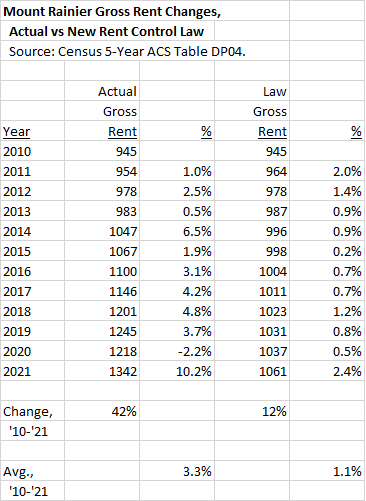By Adam Pagnucco.
In a development sure to ripple across the region, the Prince George’s County municipality of Mount Rainier has passed a rent control ordinance. Who will be next?
Mount Rainier’s ordinance, passed unanimously last Tuesday night, contains several components. First, covered rental units are limited to annual rent increases of 60% of the change in the Consumer Price Index (CPI). Exemptions include units in buildings less than 15 years old, units in buildings with two or fewer units, units in owner-occupied buildings, units that have never been previously rented, units with leases of 30 or fewer days (like Airbnb rentals) and amounts reimbursable by government entities. The bill does not indicate whether the 15 year old requirement applies to the date of the bill or if it is rolling into the future. A rent stabilization board with a majority of tenants will consider landlord requests for higher rent increases due to changes in property taxes, capital improvements and housing services.
Mount Rainier’s law allows lower increases than Takoma Park, which allows increases equal to the change in the Washington-Baltimore CPI. Currently, Takoma Park is allowing rent hikes of up to 7.3%. Another feature of Mount Rainier’s law is that its rent cap applies to vacant units – in other words, landlords cannot subject new tenants to big increases. This is different from the District of Columbia’s rent control law, which allows landlords to raise rent by up to 30% when tenants turn over. These provisions make Mount Rainier’s law a fairly tough one, particularly if its 15 year old requirement allows newer units to eventually fall into coverage.
Here are a few stats comparing Mount Rainier’s rental market to Prince George’s County and the Washington-Arlington-Alexandria metro area from the U.S. Census Bureau’s 5-year American Community Survey (ACS).
Median Gross Rent, 2021
Mount Rainier: $1,342
Prince George’s County: $1,593
Metro Area: $1,783
Increase in Median Gross Rent, 2010-21
Mount Rainier: +42%
Prince George’s County: +40%
Metro Area: +39%
Rental Vacancy Rate, 2021
Mount Rainier: 3.6%
Prince George’s County: 4.3%
Metro Area: 5.0%
Change in Number of Renter-Occupied Units, 2010-21
Mount Rainier: +26%
Prince George’s County: +18%
Metro Area: +24%
% of Rental Units with Gross Rent at 30% or More of Household Income
Mount Rainier: 46.1%
Prince George’s County: 51.6%
Metro Area: 47.0%
Looking at these stats, Mount Rainier’s rental market does not look particularly oppressive for renters. City rents are cheaper than Prince George’s County and the region and they are not growing substantially faster than either. The city has outpaced the county in rental units added over the last decade. It has a lower percentage of rent-burdened tenants than the county and the region. And while 46.1% of its tenants pay 30% or more of their household income in rent, that is down from 58.7% in 2015. What truly distinguishes Mount Rainier from the region is its rock bottom rental vacancy rate of 3.6%, down from 5.2% in 2019. That means there is high demand for rentals in the city, which makes sense given its relatively low cost, its border with D.C. and its proximity to the West Hyattsville Metro Station.
The big question is whether housing providers can afford to comply with the law. The table below shows actual gross rents in Mount Rainier since 2010 and what they would have been had the new rent control law been in effect. (The analysis assumes that Mount Rainier will use the Washington metro area CPI-U.) In real life, gross rents have been increasing in the city at a 3.3% average annual rate since 2010. If the new law had been in effect, rents would have been rising at 1.1% per year. It’s hard to see how landlords of older buildings requiring maintenance and renovations could earn a profit with 1.1% rent increases, especially in the face of rising property assessments.

Mount Rainier only has about 8,000 residents, so its law will not materially impact the region’s rental market. But Prince George’s County is about to adopt some form of rent control and Montgomery County will at least consider it. One thing about rent control laws is that their details matter a LOT. We shall see how the city’s tough new law affects the decisions of other jurisdictions going forward.
